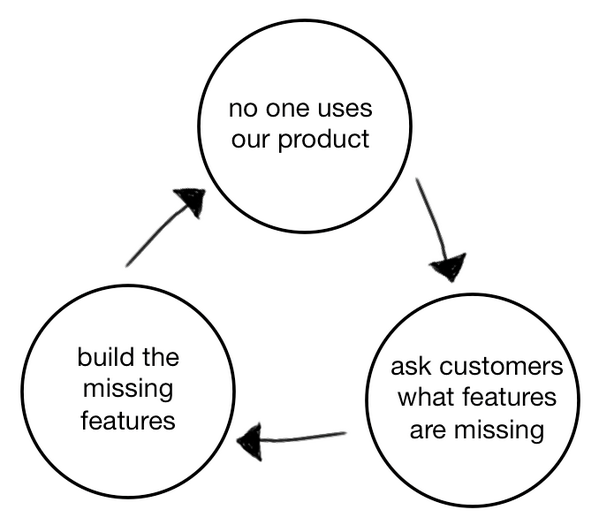You probably heard about the Product Death Cycle and the famous tweet by David Bland where he graphically depicted a serious problem that plenty of product managers are facing.
This is what I’m calling the Product Death Cycle
@davidjbland

Since David made his tweet in 2014, it has resonated with many product management folks but unfortunately this cycle is still there and will keep happening in the future specially when we look at the overwhelming statistic that 90% of software products fail!
I would like to break down this cycle in the light of my previous posts about following a systematic approach to build a product that addresses existing customer needs.
No One Uses Our Product
Well, it is absolutely fine to have no one to use your product once you launch it. The catch is to know why! Is it because of your marketing strategy, your pricing, the product itself, the user experience… etc. The list grows, but what we would like to avoid most is building a product or a feature that the customer doesn’t need!
The Solution
You need to talk to your customer and validate your persona and problem scenario hypothesis to make sure you are building the right product for the right audience.
Ask Customers What Features Are Missing
Don’t! And here are the reasons:
- Customers will often ask you for features they will not use themselves. Furthermore, the information you get from your sample customers might be skewed and don’t present the whole audience
- They will often tell you yes if you present them with any solution. They usually do so to avoid arguing with you, or they want to make you feel good in return to the motivating 30 bucks you put in their pocket, or they want to leave early… etc
- Most of users think that the more features the product has the better. They genuinely think they are helping you to make a great product, but we all know this is not the case
Best example I know is Sony’s yellow walkman problem. They presented their focus group with a solution and they asked everyone for their opinion. Most of them advocated the yellow walkman but when Sony produced it, it stayed unsold on the shelves.
The Solution
Sony has taught us a valuable lesson that we have to avoid presenting our users with a solution and asking for their opinion. Instead we need to list our assumptions and create MVP testing vehicles to validate them.
Build the Missing Feature
The third step in Product Death Cycle is to take the features our users suggested and to invest time and money to build them thinking that they will make the tipping point in our product.
The Solution
You need to be a good observer and learn why users didn’t onboard? What they expected vs what you provided? Have they boarded in large numbers and later stopped using it? How is the user experience driving sentiment? What customers are talking about us in the news and social media? Have we conducted enough experiment to know what works and what not? Are these changes going to impact the user experience and perception?
Observation and continuous learning about your customer and product usage patterns are keys to know what is missing.